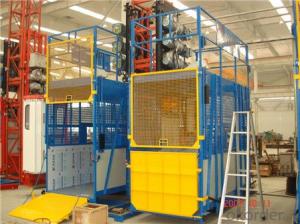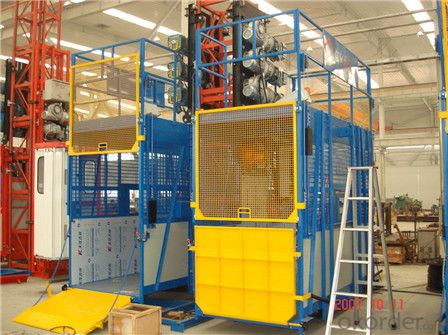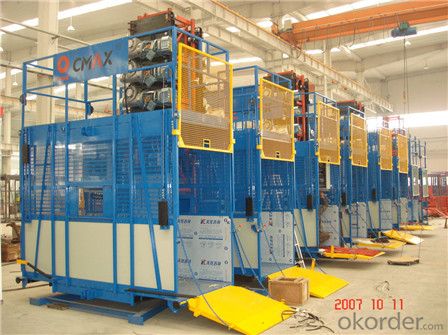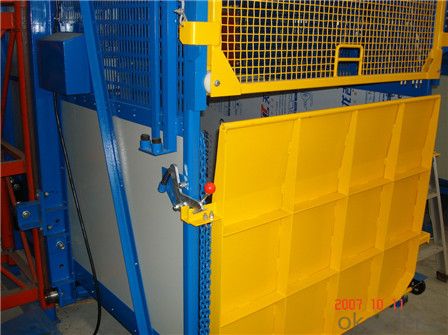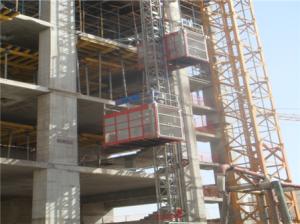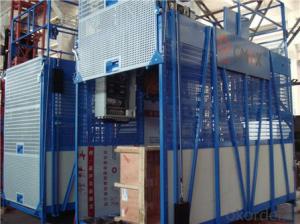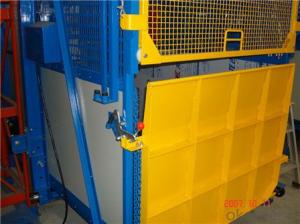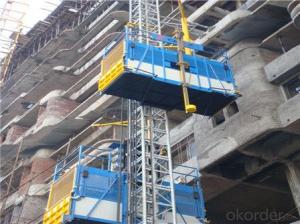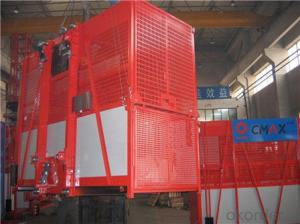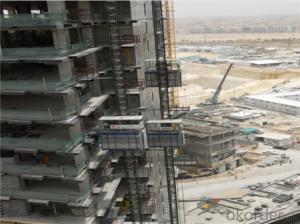CMAX Brand Building Hoist SC310/310
- Loading Port:
- Guangzhou
- Payment Terms:
- TT OR LC
- Min Order Qty:
- 1 unit
- Supply Capability:
- 50 unit/month
OKorder Service Pledge
OKorder Financial Service
You Might Also Like
Specification
Description:
Driving system consist of driving body and driving unit (Driving unit consists of motor, braking motor, coupling, worm reducer and driving gear). Driving unit is the driving part of operation, Driven by the driving unit ,the cage run up and down through the mast section guided by the roller on the driving body.
Electric lifting device is a simple lifting device which can be fixed on top of the cage. It can be transported or disassembled easily, and easy to operate and maintenance. We can use it to lift up or disassembly mast section or tie-in, etc. The max. load capacity is 250kg.
The manual winch can be used as a brake. Shake the crank in clockwise direction when lifting heavy stuff, stop shaking and release the crank, the winch can brake. Shake the crank in opposite direction when lay down the stuff.
Production details:
1. Production process: Strict material selection— blanking— inspection — welding— inspection— Blasting — inspection —Baking finished or galvanized— inspection — Finished Product
2. The product can be customized according to customers'requirements (drawing, specifications and so on).
Frequency inverter (VF) Type building construction hosit:
Characteristics | Model | Rated Loading | Lifting Speed | Motor Power | |
Double Cabin
| Low-speed | SC200/200D | 2×2000kg | 0-33m/min | 2×(3×11kw) |
SC100/100D | 2×1000kg | 0-33m/min | 2×(2×11kw) | ||
Mid-speed | SC200/200Z | 2×2000kg | 0-55m/min | 2×(2×11kw) | |
SC100/100Z | 2×1000kg | 0-55m/min | 2×(2×11kw) | ||
Single Cabin | Low-speed | SC200D | 2000kg | 0-33m/min | 3×11kw |
SC100D | 1000kg | 0-33m/min | 2×11kw | ||
Mid-speed | SC200Z | 2000kg | 0-55m/min | 2×11kw | |
SC100Z | 1000kg | 0-55m/min | 2×11kw | ||
Salient Features of Our products:
1. Mast section welded by welding Robot ensures reliable quality and elegant appearance.
2. All the steel structures are processed with blasting technology to remove rust. The adhesion of surface painting is outstanding.
3. Suspension cage guarding board adopts figured aluminum plate and numerical control punched aluminum plate. The suspension cage is lightweight and artistic in appearance.
4. Transmission mechanism supplied by the professional manufacturer has high efficiency, long service life and stability in performance.
5. Complete set of overload protection devices, variety of limiters and mechanical chain devices ensure its reliability. Anti-falling safety device, which restricts the excessive downward movement of the cage, preventing and eliminating accidents.
6. Frequency conversional construction hoist is safe, stable and comfortable. Starting electricity is smaller than working electricity, energy-saving and high efficient.
Descriptions of our building hoist:
The general building hoist manufactured by our company have the features as good quality, long life, wide application range and convenient for maintenance, the gering adopts imported bearing, enameled cable, and oil seal, the electric parts adopt products from world renowned manufactures such as Schneider, Siemens, and LG, the racks and pinion adopts special material and heat-treatment technique, which prolong the life of these parts. The steel structure uses quality steel from famous domestic manufacturers, the surface of the structure can apply paint-spray, Parkerizing baking finish or hot galvanizing processing according to users requirements, the cage can be produced and decorated by aluminum molded board, punched-plate or figured aluminum board.
Main Features of Building Material Hoist
1. the recommended cage dimension(LXWXH):2.0X1.0X2.5, 2.5X1.0X2.5, 2.5X1.3X2.5, 3.0X1.5X2.5, 3.2X1.5X2.5, 3.8X1.5X2.5, 4.0X1.5X2.5, 4.2X1.5X2.5 etc, we can also manufacture cages of other size according to the user.
2. The cage and the door material can be aluminum molded board, punched-plate, figured aluminum board or other type according to your requirements.
3. The mast and the tie-in surface can adopt paint-spray, or hot galvanizeing processing.
Cage Details.
1.The cage is boarded up by all punched aluminum sheet ,Sidewall of Wire Mesh for cage is also available. The size can be arranged to your requirement.
( Optional Size:3x1.5x2.1m, 3x1.3x2.1m, 3.2x1.5x2.1m, 3.2x1.3x2.1m, 3x1.5x2.4m, 3x1.3x2.4m, 3.2x1.5x2.4m, 3.2x1.3x2.4m)
2. Main structure of cage is made of high-quality steel after bending.(The bent steel is firm, good vertically, stability. Moreover it ensure stable of the whole structure.)
Advantage of our building hoist:
1. Our own systems of production engineering.
2. Production design from the concept to the engineering details.
3. Technical experts with great experience in the sector.
4. Continuous development of new solutions and products adapted to the requirements of our clients.
5. Methodology and project procedure administration in compliance with current guidelines.
6. Extensive worldwide commercial network
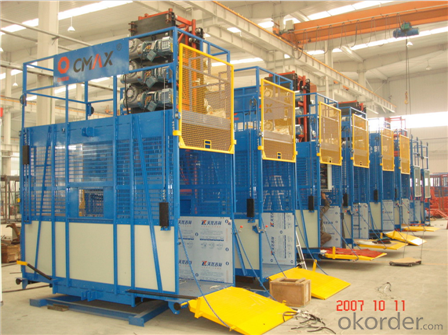
FAQ
1. why chose us?
China National Building Materials (Group) Corporation (CNBM), established in 1984,now is one of the largest stateowned group corporation in China, dealing with building materials & industrial equipment. Up to year 2010, CNBM Group's total asset is 20 billion USD and total staff is more than 100,000.CNBM International Corporation, specializes in designing & manufacturing of variouskinds of construction machinery, including tower crane, building hoist, etc. All the equipment produced by CNBM are compliant with the National level quality standard, and wins great reputation for their endurable performance in worldwide markets.
2.How about the shipment?
You can put 2 sets of of wheel loaders in one 40HQ container. The spare parts are packed with boxes.
The delivery time is 20 days.
3. What about your service?
We have our factory, we can meet customers needs as soon as possible.
We have first rate professional technology and provide good after-sales service.
4.After Sales Service
We offer the Preventative Maintenance and After Sales Service. For we strongly feels about the importance of supporting our customers and the product solutions we provide. Consequently we offer comprehensive maintenance options to prevent equipment issues before they become problems. Also we offer one year guarantee period.
- Q: This question asks if a building hoist can be utilized in both commercial and residential settings.
- <p>Yes, a building hoist can be used for both commercial and residential purposes. These hoists are designed to lift materials and workers to various levels of a building under construction. In commercial settings, they are often used in high-rise buildings, while in residential construction, they are used for multi-story homes or apartment complexes. However, the specific type and capacity of the hoist should be chosen based on the project's requirements and safety regulations must be strictly adhered to in both types of construction.</p>
- Q: This question asks for a comparison between electric and pneumatic building hoists, highlighting their distinct features and operational differences.
- <p>Electric building hoists are powered by electricity and are known for their high lifting capacity, speed, and efficiency. They are suitable for heavy-duty applications and can be automated for continuous operation. Pneumatic hoists, on the other hand, use compressed air to generate lifting force. They are quieter, require less maintenance, and are safer in environments where electrical sparks could be hazardous. However, they have lower lifting capacities and are generally slower compared to electric hoists. Pneumatic hoists are also more suitable for applications requiring precise control over the load.</p>
- Q: Is it possible to use a building hoist to lift objects that are too large to pass through a standard doorway?
- <p>Yes, a building hoist can be used for lifting objects that are too large to fit through a doorway. Building hoists are designed to handle heavy and oversized items, lifting them vertically through small openings or directly from the ground to higher floors. They are particularly useful in construction projects where large materials or equipment need to be moved to upper levels of a building. However, it's important to ensure the hoist is properly installed and operated by trained personnel to maintain safety and avoid damage to the building or the items being lifted.</p>
- Q: What measures can be taken to guarantee the smooth and reliable operation of a building hoist during lifting?
- <p>To ensure the smooth and reliable operation of a building hoist, regular maintenance and inspection are crucial. This includes checking the hoist's mechanical components for wear and tear, ensuring the electrical systems are functioning correctly, and verifying that all safety mechanisms are in place and operational. Additionally, proper lubrication of moving parts, adherence to load limits, and operator training on safety protocols are essential. It's also important to use hoists that meet safety standards and to avoid overloading. Regularly updating and upgrading the hoist system can also enhance reliability and safety.</p>
- Q: What's going on with the decline in construction lift
- Check whether the brake contactor and normal, contactor adhesion conditions will decline, brake pads have the problem not only rise to fall, fall in the same slide. If the contactor is ok, you can see that there is a groove on the brake pad, and it is only replaced if the brake is not damaged, such as cracking. If it's a frequency conversion elevator, if you're down, see if the converter has any fault code, if you have a consulting manufacturer. The assumption is that the anchuan frequency converter, which may be a real SE failure, means that the timing error is not normal for controlling the contact of the receiver.
- Q: Do the elevator need to be installed when the main project is in construction
- Installation, of course. The general building should be installed at about 10 meters on the 4th floor, or the person will go up and down the time is dangerous, and there will be some materials that can't be carried by the tower, too slowly
- Q: Is it possible to replace a building hoist with an electric winch for the purpose of lifting materials or individuals?
- <p>While theoretically possible, using an electric winch instead of a building hoist for lifting materials or people is not recommended due to safety concerns and differences in design. Electric winches are typically designed for pulling or towing loads and may not have the necessary safety features, load capacity, or stability required for lifting operations in a construction setting. Building hoists are specifically engineered to lift heavy materials and personnel safely in vertical shafts or on the facade of a building. They are equipped with safety devices and are regulated for construction use, making them the appropriate choice for such tasks.</p>
- Q: What are the primary roles or purposes that a building hoist serves in construction?
- <p>Building hoists, also known as construction hoists, serve several essential functions in construction projects. They are primarily used for the vertical transportation of workers, materials, and equipment within a building under construction. They increase efficiency by reducing the time and effort required to move materials and personnel, ensuring a faster construction process. Hoists also enhance safety by providing a controlled and secure means of vertical transportation, reducing the risk of accidents associated with manual material handling. Additionally, they contribute to the overall project timeline by allowing for simultaneous work on multiple floors, improving the coordination of construction activities.</p>
- Q: This question asks for the distinctions between two types of building hoists: manual and automatic.
- <p>Manual building hoists require human effort to operate, typically involving a pulley system and manual controls. They are generally less expensive but slower and more labor-intensive. Automatic building hoists, on the other hand, are motorized and can be programmed to lift and lower loads with minimal human intervention. They offer greater efficiency, speed, and safety, but come at a higher cost. Automatic hoists are also more suitable for high-rise construction due to their ability to handle heavier loads and operate over greater distances.</p>
- Q: Is it possible to utilize a building hoist for elevating construction materials at construction sites?
- <p>Yes, building hoists are commonly used for lifting materials at construction sites. They are designed to transport heavy construction materials and personnel vertically, which is essential for multi-story construction projects. These hoists are equipped with safety features and are operated by trained personnel to ensure the secure and efficient movement of materials and workers.</p>
Send your message to us
CMAX Brand Building Hoist SC310/310
- Loading Port:
- Guangzhou
- Payment Terms:
- TT OR LC
- Min Order Qty:
- 1 unit
- Supply Capability:
- 50 unit/month
OKorder Service Pledge
OKorder Financial Service
Similar products
Hot products
Hot Searches
Related keywords
